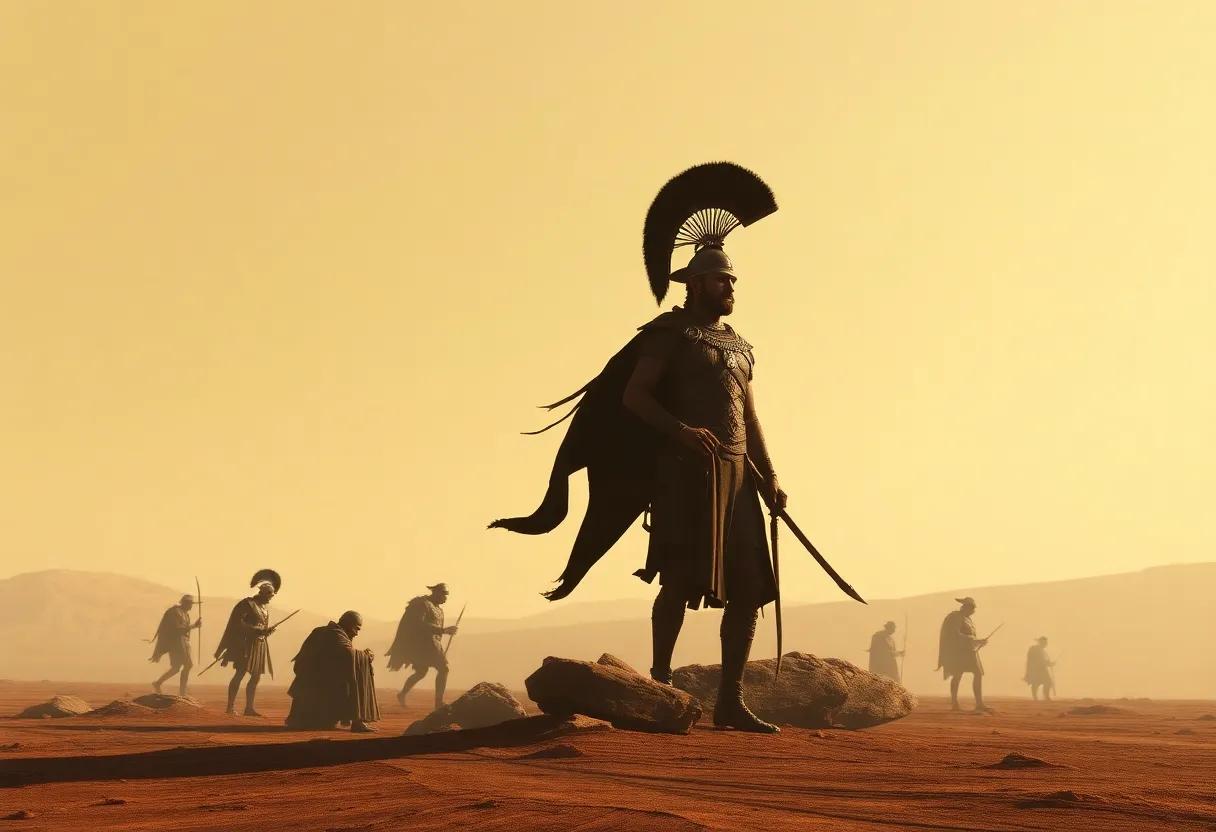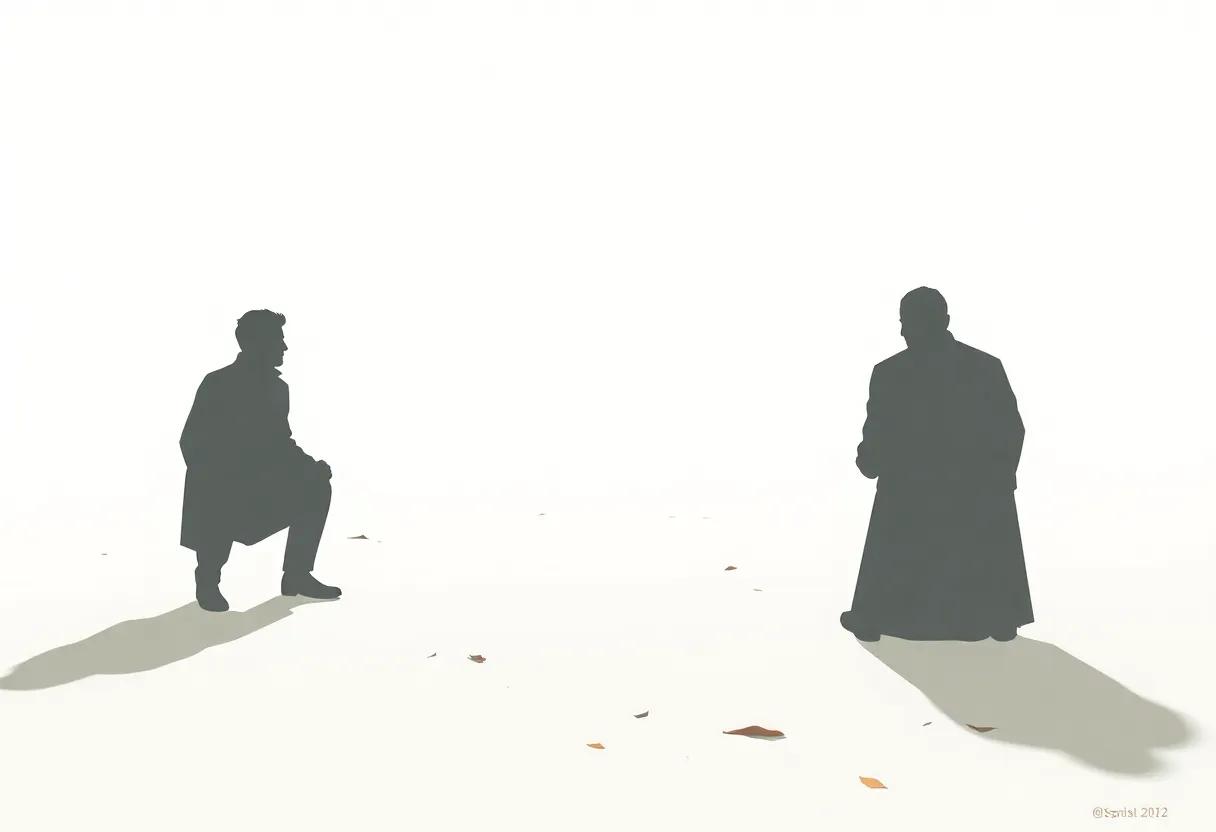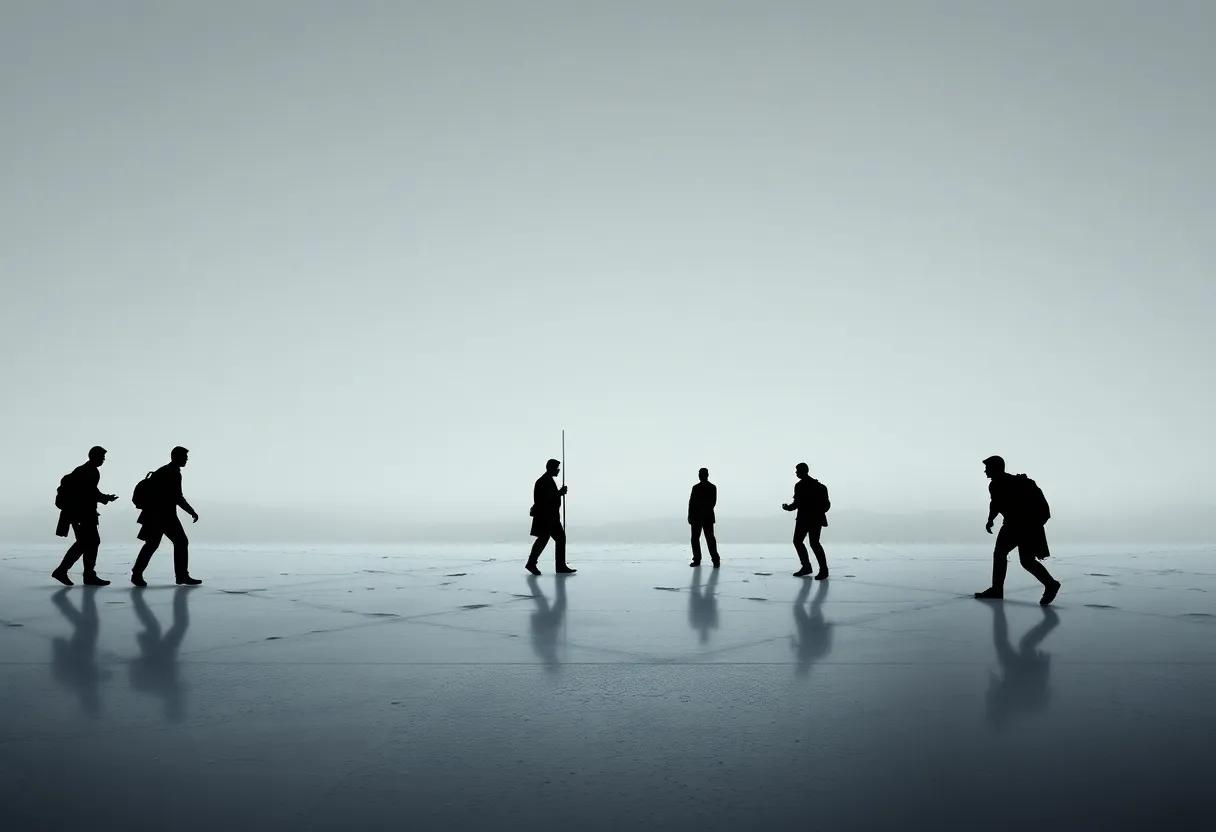In the vast landscape of postcolonial literature, few works probe the complexities of power and humanity wiht the quiet intensity found in J.M. Coetzee’s waiting for the Barbarians. Unveiling Empire’s Shadows: A Reflective Look at Waiting for the Barbarians invites readers to step beyond the surface of this evocative novel, unraveling the subtle tensions and moral ambiguities that linger in the aftermath of empire.This review embarks on a journey through Coetzee’s haunting narrative, exploring how the text deftly exposes the shadows cast by colonial rule-shadows that continue to echo in contemporary discourse. Through a measured and thoughtful lens, the discussion highlights the enduring relevance of the novel’s themes, offering insights without judgment, and opening a space for reflection on the enduring complexities of justice, power, and empathy.
The Lingering Echoes of Colonial Power and Moral Ambiguity in Waiting for the Barbarians

In Waiting for the Barbarians, the vestiges of colonial authority are portrayed not merely as a backdrop but as a living entity-fractured, conflicted, and suffused with a pervasive moral ambiguity. The Empire’s grip is symbolized through the magistrate’s internal struggle, revealing how power can both corrupt and isolate, blurring the lines between oppressor and victim. This ambiguity forces readers to confront uncomfortable questions about justice and complicity within systems that thrive on domination and fear. The narrative elegantly unravels the fragile facade of civilization, exposing deep-rooted anxieties and contradictions at the heart of imperial enterprise.
At the core of this reflection lies a tension between authority and vulnerability, further expressed through recurring motifs:
- The unseen enemy: a fear fueled less by reality and more by projections of insecurity.
- Absence of clear moral boundaries: challenging the binary of good versus evil.
- Isolation of the individual: the magistrate’s journey as a metaphorical exile from both empire and indigenous people.
| Element | Symbolism | Impact on Narrative |
|---|---|---|
| The Empire | Decaying power and control | creates tension and uncertainty |
| the Barbarians | The unknown and feared “other” | Highlights paranoia and prejudice |
| The Magistrate | Moral introspection and loss | Drives ethical questioning |
Exploring the Symbolism and metaphors that Illuminate Empire’s Complex Shadows

In Waiting for the Barbarians, the empire’s landscape unfolds as more than mere setting-it becomes a palimpsest of power and paranoia, etched with symbols that speak to the fragility of authority. The magistrate’s journey into the unknown borderlands mirrors the internal dissolution of the empire’s ideological certainty. The “barbarians,” rather than being external threats, act as metaphors for the suppressed fears and insecurities lurking within the empire itself.Here, shadows manifest not only as the absence of light but as the deliberate obscuring of truth-creating a space where justice is twisted and humanity becomes collateral damage in the name of security.
The intricate layering of metaphors invites readers to reflect on the corrosive effects of colonialism, imperialism, and moral complicity.Consider these potent symbols:
- The Empty Railroad: A path to nowhere, illustrating promises of progress built on exploitation and fear.
- The Barbarian Watchtower: A high vantage point symbolizing surveillance, suspicion, and the precarious balance of power.
- The Magistrate’s Glasses: Offering distorted views-symbolic of how perception is manipulated under imperial rule.
| Symbol | Meaning | emotional Resonance |
|---|---|---|
| Darkened Outpost | Isolation and decay of imperial influence | Desolation, uncertainty |
| Barbed Wire | Boundaries and oppression | Confinement, hostility |
| Silent Sentries | Omnipresent but ineffective power | Fear, impotence |
Character Arcs and Their Reflections on Innocence, Corruption, and Resistance

The narrative weaves intricate character arcs that act as mirrors reflecting the fragile interplay between innocence, corruption, and resistance. The Magistrate, initially embodying a naive adherence to imperial order, gradually confronts the corrosive influence of power and prejudice. His transformation highlights how innocence is not merely lost but challenged by ethical dilemmas, revealing cracks in the empire’s moral facade. In contrast, the barbarian girl symbolizes purity and resilience, standing as a beacon of defiance against systemic oppression. Together, their trajectories underscore the complex dance between submission and rebellion within colonial rule.
- Innocence: Fragility exposed by imperial dominance
- Corruption: Power’s erosion of ethical integrity
- Resistance: The courage to defy and reclaim identity
These contrasting journeys invite readers to examine the multifaceted nature of complicity and dissent. The Magistrate’s grappling with his conscience mirrors the broader societal tensions where collaboration and opposition intertwine. Simultaneously occurring, acts of resistance, both subtle and overt, challenge the pervasive narrative of empire, suggesting that even within oppression, the seeds of change persist. This dynamic allows the story to transcend its setting, offering a timeless exploration of human morality.
| Character | Arc | Symbolism |
|---|---|---|
| The Magistrate | From obedience to moral awakening | Innocence lost in empire’s shadow |
| The Barbarian Girl | Victim to resilient icon | Resistance and unyielding purity |
| Colonel Joll | Agent of ruthlessness and fear | Corruption personified |
The Narrative Structure’s Role in Building a Tense and Thought-Provoking Atmosphere

At the heart of Waiting for the Barbarians lies a narrative structure that masterfully interlaces tension with introspection, compelling readers to confront the blurred boundaries between civilization and savagery. The novel’s nonlinear progression, punctuated by fragmented memories and shifting perspectives, mirrors the protagonist’s internal disarray and the empire’s creeping decay. This fragmented storytelling doesn’t just build suspense-it invites readers to question the reliability of truth within a world fraught with moral ambiguity. Each chapter acts like a shadowy corridor, where sudden revelations lurk in unexpected corners, forcing an unsettling reckoning with the cost of power and oppression.
- Unfolding ambiguity: The story deliberately resists a straightforward timeline,challenging the reader’s assumptions.
- Psychological depth: stream-of-consciousness passages reveal the protagonist’s conflicted conscience.
- Atmospheric pacing: Slow-building tension underscores the dread simmering beneath the imperial surface.
To better understand how the narrative mechanics intensify the novel’s brooding atmosphere, consider this simplified breakdown of key structural elements and their emotional impact:
| Structural element | Effect on Atmosphere | Reader’s Experience |
|---|---|---|
| Fragmented chronology | Creates disorientation and suspense | Heightened alertness, curiosity |
| First-person introspection | Deepens moral complexity | Empathy mixed with unease |
| Sparse dialogue | Amplifies isolation and silence | Sense of claustrophobia, tension |
How Setting and Landscape Mirror the Psychological and Political Themes of the Novel

The stark, arid landscape in waiting for the Barbarians serves as more than just a backdrop; it is a living reflection of the pervasive emptiness and moral desolation within the Empire itself. The barren desert, vast and unforgiving, mirrors the psychological exile felt by the Magistrate, whose internal conflicts echo the external barrenness. This setting strips away the illusion of civilization, exposing the rawness beneath colonial pretenses. The Empire’s outpost, seemingly a frontier of order and control, instead becomes a liminal space where the boundaries between oppressor and oppressed blur, much like mirages on the horizon that distort reality and heighten tension.
Within this confined, desolate environment, the political themes take on a tangible form. The isolation of the frontier outpost symbolizes the isolationist mentality of authoritarian regimes, desperately clinging to power through fear and suspicion. Key elements of the landscape that reinforce the novel’s themes include:
- Endless, empty deserts illustrating the desolation of lost moral compass.
- remote military fortifications embodying rigid control and surveillance.
- encroaching wilderness symbolizing both external threats and internal chaos.
| Landscape Element | Psychological Mirror | Political Symbolism |
|---|---|---|
| Barren Desert | Emptiness & isolation | Decay of imperial ideology |
| Outpost Fortress | Confined conscience | Authoritarian control |
| Unseen Borders | uncertainty & fear | Oppression of ‘the other’ |
Unpacking the Themes of Justice, Oppression, and Complicity within the Empire’s Domain
At the heart of the narrative lies a complex interrogation of justice - not as an abstract ideal but as a malleable concept twisted within the machinery of empire. The enforcers of imperial law cloak their actions in righteousness, yet their pursuit of order often manifests as arbitrary violence and fear-mongering. This juxtaposition reveals how justice, when wielded by colonial powers, becomes less about fairness and more about maintaining dominance. The blurred lines between right and wrong force readers to question the validity of the empire’s moral claims and the cost of peace built on oppression.
- Oppression: The systematic subjugation of the so-called “barbarians” exposes the dehumanizing tactics employed to justify control.
- Complicity: The silent acquiescence of bystanders highlights how societies participate in perpetuating injustice through passivity.
- Resistance: Small acts of dissent ripple beneath the surface, hinting at inevitable upheaval against imperial authority.
| Theme | Manifestation | Impact |
|---|---|---|
| Justice | Skewed laws, moral ambiguity | Maintains power, erodes truth |
| Oppression | Surveillance, fear, and violence | Suppresses identity, breeds resentment |
| Complicity | Silent observers, participation | Enables continuity of power structures |
The Impact of Waiting for the Barbarians on Contemporary Views of Colonialism and Empire
Waiting for the Barbarians invites readers to confront the often invisible consequences of colonial power dynamics, challenging the sanitized narratives that have long dominated conventional histories. It exposes how the myth of the “civilized” empire and the ”barbaric” other is a constructed narrative used to justify domination and control. Through its poignant storytelling, the novel questions the moral complacency of imperial agents, revealing the psychological and ethical toll of sustaining an empire built on fear and misrepresentation. in doing so, it stirs contemporary audiences to reassess the inherited ideologies that continue to influence modern perspectives on colonialism and empire-building.
- Deconstruction of Empire Myths: The novel dismantles the simplistic binaries between colonizer and colonized, encouraging a nuanced understanding of cultural encounters and power struggles.
- Moral Ambiguity and Obligation: It foregrounds the internal conflicts of individuals complicit in imperial systems, emphasizing accountability beyond ancient distance.
- Enduring Legacies: The themes resonate with contemporary global issues such as cultural erasure, systemic violence, and identity crises born from colonial histories.
| Aspect | Contemporary Reflection |
|---|---|
| Narrative Control | Media and history-telling shaping modern identities |
| Power Relations | Persistent socio-political inequalities worldwide |
| Cultural Erasure | Challenges in preserving indigenous languages and traditions |
Stylistic Choices and Language that Enhance the Poignant and Reflective Tone
coetzee’s use of sparse yet evocative language creates a mood thick with introspection. The restrained dialogue and measured descriptions compel readers to linger over each sentence, mirroring the protagonist’s own internal conflict. This economy of words avoids melodrama, rather fostering a quiet tension that underscores the moral ambiguity permeating the narrative. Moreover, the juxtaposition of stark imagery with subdued emotion amplifies a sense of haunting regret, forcing us to grapple with the uncomfortable truths lurking beneath the surface of empire and power.
Another hallmark of the text is its rhythmic structure and pacing, which oscillate between deliberate calm and abrupt bursts of chaos. this ebb and flow reflect the psychological turmoil experienced by the characters, subtly guiding readers through a landscape where certainty dissolves into doubt. Elements such as repetition and strategic pauses not only reinforce central themes but also invite reflection on the cyclical nature of oppression. Consider the following table, which outlines some of the key stylistic devices and their emotional impact:
| Stylistic Device | Effect on Tone | Example |
|---|---|---|
| Metaphor | Deepens symbolic resonance | “Empire’s shadows” |
| Repetition | Creates haunting rhythm | “Waiting, waiting…” |
| Ambiguous Pronouns | Invokes uncertainty and detachment | “Thay,” “Them” |
Balancing Historical context with Timeless Questions of humanity and Power Dynamics
In discussing Waiting for the Barbarians,it becomes clear that the narrative transcends its immediate historical backdrop to probe deeper into the essence of human nature and the persistent mechanisms of power. The setting, though distinctly imperial, serves as a canvas upon which the play of fear, authority, and innocence unfolds timelessly. This duality invites readers to reflect on how societies, regardless of era, grapple with the *other*-a concept perpetually shaped by suspicion and control. The text unravels the complexities of dominance not merely as political strategy but as a human condition fraught with moral ambiguity.
Crucially, the novel compels us to consider several enduring questions:
- How does fear manipulate truth and justice?
- In what ways do power structures define and distort human relationships?
- What is the cost of remaining silent in the face of oppression?
These themes ripple through the story’s atmosphere, giving rise to moments where characters’ internal conflicts resonate beyond their imperial confines. Below is a brief thematic comparison emphasizing the interplay between historical forces and universal human dilemmas:
| Historical Element | Timeless Question | Illustrative Example |
|---|---|---|
| Colonial Misrule | What happens when power lacks accountability? | Judge’s internal struggle with authority |
| fear of the ‘Other’ | How does fear justify cruelty? | Barbarians as scapegoats for empire’s anxieties |
| Silent Witness | What role does complicity play in oppression? | Official’s hesitation to confront injustice |
Why Waiting for the Barbarians Remains a crucial Read in Understanding Imperial Legacies
At the heart of the narrative lies a profound exploration of power dynamics and the human cost embedded within imperial rule. The novel strips away the glorified myths of empire to reveal a raw,unsettling tableau where fear,suspicion,and the arbitrary exercise of authority dictate the fate of entire populations. its relevance endures as it confronts readers with uncomfortable questions about complicity, moral ambiguity, and the mechanisms through which domination is sustained.These themes resonate as much today as they did at the time of its publication, reminding us that the legacy of empire continues to influence contemporary geopolitics and social hierarchies.
Key elements that reinforce its timeless impact include:
- Psychological interrogation of both oppressor and oppressed, humanizing all sides while exposing systemic flaws.
- Symbolism that transcends specific historical contexts, portraying empire as a universal phenomenon.
- complex characters whose internal conflicts mirror the external chaos of colonial entanglements.
| Aspect | Imperial Legacy Insight |
|---|---|
| Authoritarianism | Illustrates dependency on fear to maintain control |
| Cultural Erasure | Highlights silent destruction beneath enforced ‘civilization’ |
| Resistance | challenges simplistic hero/villain dichotomies |
Recommendations for Readers Interested in Postcolonial Literature and Moral Philosophy
For those drawn to the intricate dance between power, identity, and ethics that Waiting for the Barbarians masterfully explores, diving deeper into both postcolonial literature and moral philosophy can illuminate new perspectives. Works by authors such as Chinua Achebe and Gayatri Spivak unravel the complex narratives of colonized peoples, highlighting voices suppressed by imperial rhetoric.Pairing these literary explorations with philosophical treatises by figures like Hannah Arendt or Emmanuel Levinas enriches understanding of the ethical dilemmas embedded in colonial encounters and the idea of “the Other.”
Consider exploring the following to expand your journey:
- Things Fall Apart by Chinua Achebe – a poignant counter-narrative to imperial histories.
- In Other worlds by Gayatri Chakravorty Spivak – essays on subaltern studies and critical postcolonial thought.
- The Origins of Totalitarianism by Hannah Arendt – crucial for understanding sovereignty and authoritarian systems.
- Totality and Infinity by Emmanuel Levinas – philosophy centered around ethics and the face-to-face encounter with the Other.
| Category | Recommended Author | Key Contribution |
|---|---|---|
| Postcolonial Literature | Salman Rushdie | Explores hybridity and magical realism |
| Moral Philosophy | Frantz Fanon | Psychological effects of colonization |
| Intersectional Thought | bell hooks | Race, gender, and cultural critique |
The Influence of J. M. Coetzee’s Personal Insights on the Narrative Depth and Complexity
J. M. Coetzee’s intimate understanding of power dynamics, born from his South African roots and experiences during apartheid, infuses the narrative with an unparalleled authenticity.His personal insights enable a probing portrayal of colonial paranoia and moral ambiguity, allowing readers to navigate the labyrinth of empire and resistance with nuanced sensitivity. This depth is not merely academic; it resonates with the psychological fragility of those who both enforce and suffer domination.Through his characters, Coetzee channels the personal as political, demonstrating how imperial oppression fractures individual identity and collective conscience alike.
The complexity in waiting for the Barbarians also stems from Coetzee’s deliberate use of ambiguity and conflicting perspectives, reflecting his contemplations on justice and complicity. The narrative resists simple binaries, instead presenting a world where guilt, innocence, and cruelty intermingle in unsettling patterns. This layered storytelling invites readers to wrestle with uncomfortable truths rather than seek clear resolutions. Consider the following table outlining some key thematic elements and their reflections of Coetzee’s own grappling with empire:
| Theme | Coetzee’s Personal Reflection | Narrative Expression |
|---|---|---|
| Moral uncertainty | Conflicted conscience amid systemic injustice | Ambiguous narrator, blurred lines between oppressor and victim |
| Isolation | Alienation in a divided society | Protagonist’s solitude and existential questioning |
| Resistance | Subtle defiance against oppressive structures | Quiet acts of rebellion, coded symbolism |
- Psychological Realism: Character motivations informed by Coetzee’s reflections on trauma and power.
- Ethical Ambiguity: Challenges the reader to question absolute truths within colonial contexts.
- Symbolic Nuance: Use of landscape and silence as metaphors for empire’s unseen scars.
In peeling back the layers of Waiting for the Barbarians, Unveiling Empire’s Shadows invites readers to confront the enduring complexities of power, morality, and identity.This reflective journey doesn’t offer easy answers but instead illuminates the shadows cast by empire-from both the oppressor and the oppressed. Whether one approaches the novel as a historical allegory or a timeless meditation, its haunting questions linger long after the final page, reminding us that the boundaries we imagine are often the ones that bind us most tightly.










